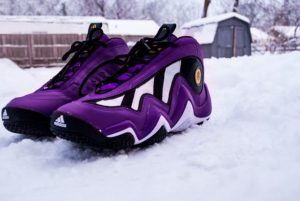Previously, the onset of winter cold for lovers of sporty clothing became a real agony of choice: continue to wear light sneakers and freeze, or abandon very comfortable shoes in favor of warm boots or boots. Today, the life of sport style followers has been made easier by the appearance on the shelves of branded stores of the most famous sports brands of sneakers, adapted for wear in the cold season. Let's find out what to look for when buying a pair of winter sneakers, and what recommendations exist on how to choose them.
Features of choosing winter sneakers

Sneakers themselves are a fairly versatile type of footwear that most people use for other than sports activities. Today, sneakers have become the most popular shoes, primarily because they are very convenient and comfortable to walk in. More and more girls are forgetting about high-heeled shoes and pointed boots, wearing stylish Nikes or Adidas under dresses and miniskirts.
The most famous designers sensed this trend and, as one, began to release exclusive collections of sneakers, for which both women and men lined up on the day sales began.
The same thing happens with sports shoes for wearing in the cold season. Previously, it was quite difficult to find a pair that fit the size and external criteria; today, winter sneakers are sold on a par with summer sneakers.
Attention! The main difference between winter sneakers and summer models is their ability to keep your feet warm and dry. You can easily walk in them and even run on ice and snow.
These qualities are realized through:
- water- and dirt-repellent outer layer;
- a sole made of dense and at the same time flexible materials with a clearly defined tread;
- presence of internal insulation;
- good ventilation;
- rubber built-in or removable studs in the sole;
- reflectors.
Important! The presence of reflective elements in the design of shoes does not make them warmer or more resistant on ice, however, they are one of the key attributes. The early onset of darkness in winter provokes many accidents with people moving along roadways, and the presence of reflectors on shoes and clothing helps to avoid this.
Which sneakers to take for the winter: important parameters

Only shoes used for special occasions can be uncomfortable and unnatural, for example, very beautiful dress shoes with high heels, which can only be worn for going to a restaurant or club. Sneakers that are worn every day, even in winter, must be of high quality and comfortable.
When you are lost in choosing among the huge variety of models presented in stores, you should pay attention to the following important points:
- Impregnation of the top layer with water-repellent compounds. Natural leather and suede have water-repellent properties, which are sometimes ensured by the owners of shoes made from these materials by using special sprays and lotions. However, if there is no spray on hand, and there is heavy snow and rain outside, untreated suede may get wet and become deformed. For winters with unstable weather conditions, it is better to purchase a pair of sneakers impregnated with water-repellent compounds during the manufacturing process;
- Presence of membrane gasket. A membrane gasket (Gore-Tex) located between the outer covering and the lining provides thermal insulation and free air circulation inside the winter boots. It does not allow snow or rain to penetrate inside and removes the perspiration generated during walking. They are not hot indoors and not cold outside at five degrees below zero;
- Insulated lining. In severe frosts it will not be possible to do without additional insulation. Among the popular insulation for winter sneakers, the most popular are: attractive-looking faux fur, which allows the feet to breathe, has high thermal insulation and a good warming effect, a combination of suede and faux fur called “sherpa”, a synthetic bird down substitute that provides warmth and dryness to the feet and does not weigh down the shoes;
- The presence of a sock made of microporous rubber neoprene inside the sneaker. Neoprene is considered a durable material that is resistant to the development of fungus and other bacteria.A neoprene sock sewn and inserted inside the boot retains heat and does not allow moisture to pass through;
- Sole. The sole is made of thin and low-quality material making the shoes unsuitable for walking through snow, puddles and ice. In addition, under the influence of low temperatures, it can simply burst or crack in some places, thereby giving free access to cold air and moisture to the feet. The correct sole should be thick and textured with many bulges and indentations. Spikes, which can be either built-in or removable, will also be useful.
Recommendations for choosing winter sneakers

In order to make sure you don’t make a mistake with your choice and make a successful purchase, you need to listen to the advice of professional athletes, who certainly know which shoes will be comfortable in winter. You should take into account:
- Shoe height. Even the best quality sneakers made from natural and moisture-resistant materials cannot be worn in winter if they are too low and open. The best option is considered to be boots that cover at least part of the lower leg;
- Color. An unexpected fact is that for our winters it is better to buy shoes in white rather than black. Dark materials react worse to contact with reagents that are sprinkled on roads, becoming covered with white streaks and spots;
- Laces. If they are present on shoes, then the laces should be tied tightly, so that they do not have to be constantly adjusted while outside.
When purchasing a new pair of shoes, it is important to consider that the temperature range indicated on the box refers solely to the ability of the shoes to maintain their quality and not deteriorate. Whether the buyer will be comfortable depends entirely on other factors.


 0
0





